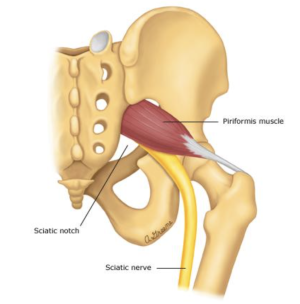Piriformis syndrome
Last edited on : 22/09/2024
Piriformis syndrome is a chronic pain syndrome resulting from compression of the sciatic nerve by the piriformis muscle.
It is a rare syndrome, essentially a clinical diagnosis of exclusion. Its therapeutic management is the responsibility of physical medicine and/or orthopedic surgery.
Pathophysiological elements

This syndrome results from the compression of the sciatic nerve by the surrounding muscles at its emergence between the piriformis muscle above and the hip rotator muscles below.
It is important to note that the very existence of this syndrome remains debated within the medical community.
Clinical Presentation
The symptoms typically consist of chronic paroxysmal pain and/or paresthesias starting in one buttock and extending down the back of the thigh, and more rarely, down to the back of the calf and foot. These symptoms are typically triggered by certain activities or positions that promote compression of the sciatic nerve by the piriformis muscle, such as prolonged sitting – sometimes even lying down – running, or repeated hip flexion movements (e.g., climbing stairs), or cycling.
There are usually no other manifestations.
Differential Diagnosis
The main differential diagnosis is lumbosacral radiculopathy (primarily S1), which is far more common. Clinical features generally help establish this diagnosis (chronic low back pain, "bell sign", Lasègue's sign, etc.). In case of doubt, lumbosacral imaging can help confirm or exclude a radicular conflict.
Any compression of the sciatic trunk by another structure, such as a tumor or an inflammatory condition in the region, can present with similar symptoms.
More marginally, other differential diagnoses can sometimes be considered. However, their clinical presentations are usually distinct enough to avoid confusion: spondyloarthritis ("alternating buttock pain", spinal pain, "intercostal" pain, scapular pain, etc.), hip pathology (localized pain on palpation and mobilization, etc.).
Additional Tests
No additional tests are necessary or sufficiently sensitive or specific to establish a positive diagnosis, which remains mainly clinical and by exclusion.
The prescription of additional tests is primarily driven by the need to rule out specific differential diagnoses. In practice, lumbosacral and pelvic MRI are typically performed.
Lumbosacral CT or MRI
Its sole purpose is to help exclude radicular compression that could explain the clinical presentation.
Pelvic MRI
It is not useful for a positive diagnosis. However, it can help rule out sciatic nerve compression by a structural lesion in the region (e.g., tumor).
Ultrasound of the Gluteal Region
When performed by an experienced radiologist, it can, through provocative maneuvers, potentially reproduce the symptoms and demonstrate concomitant sciatic nerve compression by the piriformis.
Electrophysiological Tests: Nerve Conduction Studies (NCS), Electromyography (EMG), and Evoked Potentials
These tests are not very specific in this case and are usually normal. Additionally, the EMG component can only be performed by a specialized electrophysiologist.
Other Tests
In rare cases, if the clinical presentation suggests other conditions, additional tests may be justified to exclude them, such as blood tests, sacroiliac MRI, bone scintigraphy, or hip imaging.
Treatment and Management
Management falls under the purview of orthopedics or physical medicine. It usually consists of:
- Avoiding activities and positions that trigger the pain
- Physical therapy (hip and piriformis muscle stretching)
In cases of persistent symptoms, the use of oral NSAIDs and corticosteroid injections under ultrasound guidance can be considered.
In extremely rare cases, surgery may be discussed if the syndrome is resistant to all other forms of management.
Bibliography
Alpin RJ et Ganju A, Piriformis syndrome: a real pain in the buttock?, Neurosurgery, 2009 Oct
Kirschner JS et al., Piriformis syndrome, diagnosis and treatment, Muscle Nerve, 2009 Jul